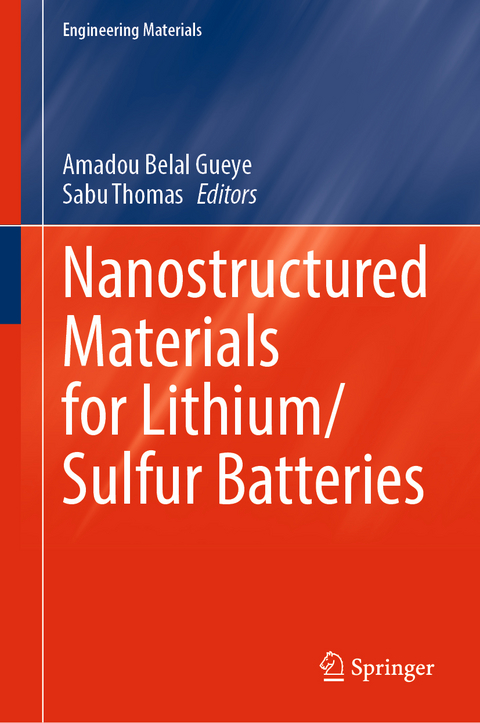
Nanostructured Materials for Lithium/Sulfur Batteries
Springer International Publishing (Verlag)
978-3-031-66225-6 (ISBN)
This book delves into the key aspects of lithium/sulfur batteries, exploring their electrochemistry, reaction mechanisms, disadvantages, and characterization methods. It highlights recent advances in designing nanostructured electrode materials, including various carbon-host materials, polymer-derived materials, binder-free sulfur-hosts, and metal oxides. The impact of these nanostructures on battery properties such as capacitance, rate capability, and cycle stability is discussed, providing guidelines for future electrode design. The book also reviews the progress in electrolytes and the development of advanced separators, such as functionalized polyolefins, carbon-metal oxide hybrids, and electrospun materials, and presents the future outlook and challenges in this field.
Amadou Belal Gueye is a research scholar at the School of Chemical Sciences, Mahatma Gandhi University, Kottayam, Kerala, India. He received his bachelor's degree in Physics-Chemistry and his master's degree in Physical Chemistry Applied to Energy and Analysis from Cheikh Anta Diop University of Dakar, Senegal. His research focuses on energy storage within the framework of his thesis.
Prof. Sabu Thomas is the chairman of Trivandrum Engineering Science & Technology Research Park (TrEST Research Park). He also serves as the director of the School of Energy Materials, the School of Nanoscience and Nanotechnology, and the International and Inter-University Centre for Nanoscience and Nanotechnology at Mahatma Gandhi University, Kottayam, Kerala, India. Prof. Thomas was the vice-chancellor of Mahatma Gandhi University (2019-2023) and is internationally acclaimed for his work in Nanoscience and Polymer Science and Engineering.
Part 1: Introduction to Lithium/Sulfur Batteries.- Chapter 1: Introduction, History, Advantages and Main problems in Lithium/Sulfur Batteries Systems.- Chapter 2: Electrochemistry and Basic Reaction Mechanism of Lithium metal/Sulfur Batteries.- Chapter 3: Characterization Methods for Lithium/Sulfur Batteries.- Part 2: Host Nanostructured Materials for Sulfur Cathode.- Chapter 4: Typical carbon-host materials.- Chapter 5: One-dimensional carbon-based host materials.- Chapter 6: Two Dimensional Carbon-Host Materials.- Chapter 7 : Three Dimensional Carbon Host Materials.- Chapter 8: Polymer Derived Carbon-Host Materials.- Chapter 9: Binder-free sulfur host materials.- Chapter 10: Metal Oxides as Sulfur Host Cathodes.- Part 3: Nanostructured Lithium Sulfide Cathode Materials for Lithium/Sulfur Batteries.- Chapter 11: Problems and Challenges in Lithium Sulphide Cathode.- Chapter 12: Lithium sulfide (Li2S)-metal nanocomposites.- Chapter 13 : Li2S-carbon nanocomposites.- Part 4: Nanostructured Hybrid Cathode Materials for Lithium/Sulfur Batteries.- Chapter 14: Carbon-based nanocomposites .- Chapter 15: Metal Oxides based nanocomposites for Lithium-Sulfur Batteries.- Chapter 16: Conducting polymers-based Nano composites.- Part 5: Nanostructured Electrolyte Materials for Lithium/Sulfur Batteries.- Chapter 17: Aqueous Electrolytes for Lithium Sulfur Batteries.- Chapter 18: Non-Aqueous Electrolytes For Lithium-Sulfur Batteries.- Chapter 19: Ionic Liquid-Based Electrolytes for Lithium/Sulfur Batteries.- Chapter 20: Polymer Electrolytes for Lithium/Sulfur Batteries.- Chapter 21: Hybrid electrolytes for Li-S batteries.- Part 6: Nanostructured Separator and Interlayer Materials for Lithium/Sulfur Batteries.- Chapter 22: Different types of separators for Lithium sulfur battery.- Chapter 23: Functionalized polyolefin separators for lithium/sulfur batteries.- Chapter 24: Carbon-based interlayers.- Chapter 25: Carbon-metal oxide hybrid nanocomposites.- Chapter 26: Doped carbon-based materials as Li-S battery separator.- Chapter 27: Metal-doped carbon based nanostructured separator materials for Lithium/Sulfur Batteries.- Chapter 28: Polymer blend separators.- Chapter 29: Electrospun Nanofibers.- Part 7: Nanostructured anode Materials for Lithium/Sulfur Batteries.- Chapter 30: Stabilized lithium metal nanocomposite anode for high-performance lithium-sulfur batteries.- Chapter 31: Carbon-Li Nanocomposites as anode for lithium-sulfur battery.- Chapter 32: Silicon Based Materials.- Chapter 33: Silicon-Carbon-Lithium Hybrid Nanocomposites.- Part 8: Future Outlooks and Challenges.- Chapter 34: Lithium-Sulfur Batteries: from Lab to Industry and Safety.- Chapter 35: Future Market and Challenges of Lithium/Sulfur Batteries.- Chapter 36: Life cycle analysis of lithium sulfur batteries.
| Erscheinungsdatum | 20.09.2024 |
|---|---|
| Reihe/Serie | Engineering Materials |
| Zusatzinfo | XII, 741 p. 291 illus., 257 illus. in color. |
| Verlagsort | Cham |
| Sprache | englisch |
| Maße | 155 x 235 mm |
| Themenwelt | Naturwissenschaften ► Chemie ► Physikalische Chemie |
| Technik ► Maschinenbau | |
| Schlagworte | Applications • Composites • LITHIUM/SULFUR BATTERIES • Nanocomposites • nanostructured • sulphur cathodes |
| ISBN-10 | 3-031-66225-3 / 3031662253 |
| ISBN-13 | 978-3-031-66225-6 / 9783031662256 |
| Zustand | Neuware |
| Informationen gemäß Produktsicherheitsverordnung (GPSR) | |
| Haben Sie eine Frage zum Produkt? |
aus dem Bereich


